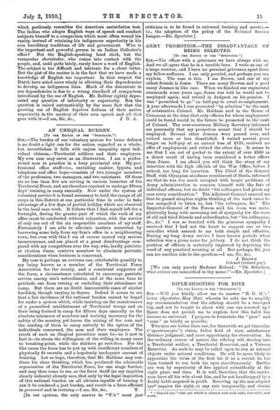RIFLE-SHOOTING FOR BOYS.
[To THE EDITOR OF THE "SPECTATOR."] Srn,—Will you kindly allow me to answer "E. G. M.'s" letter (Spectator, May 21st) wherein he asks me to amplify my recommendation that the rifleboy should be a two-eyed boy, and not be taught to shoot with one eye screwed up Space does not permit me to explain how this habit has become so universal. I propose to formulate the "pros" and " cons " as briefly as possible.
Two eyes are better than one, for therewith we get binocular (" spectroscopic"). vision, fuller field of view, satisfactory distance judgment, and more opportunity for observation. In the ordinary course of nature the rifieboy will develop into a Territorial soldier, a Territorial Reservist, and a Veteran Reservist. As such he may be called upon to aim at natural objects under natural conditions. He will be more likely to appreciate the value of the first hit if as a recruit he has been trained to use both his eyes simultaneously. Battles are won by superiority of fire applied scientifically at the right place and time. It is well, therefore, that the marks- man have all his wits about him, and be not handicapped by a faulty habit acquired in youth. Screwing up the non-aligned eye* impairs the sight, at any rate temporarily, and strains
"Aligned eye,"—the eye which is aligned with back-sight, fore-sight, and mark.
the rifleboy. In two-eyed shooting each eye "fixes" the same portion of the distant mark, and it is all-important in these days of " figure targets " and difficult marks that the valuable help given by the non-aligned eye should be available.
With practice the rifleboy soon learns to "get on " instan- taneously and simultaneously with breathing inhibition and trigger-squeeze, with both eyes open. The efficient shot fixes his gaze upon the mark, not upon the sights, once he has his rifle in position. With both eyes open the " fixing " of the mark comes naturally without effort (static refraction). The rifleboy should get his shot off rapidly to avoid wind variation and disappearance of the mark. A recruit whose position is defective fails to " get on." He is apt to try for his alignment by shifting his head and fore-limbs uncomfortably. He will make a bad shot. He should rather shift his body until the sights and mark are aligned. He will make a good shot. I leave "E. G. M." to think out the reason for this difference in result.
I do not intend to adduce examples of two-eyed marksmen. They are numerous amongst the Boers, and elsewhere. Some of the best marksmanship I have seen has been by two-eyed rifleboys. I know of no valid argument against the use of toth eyes in rifle-shooting. The military authorities, con- fronted with adolescent recruits, have found it less trouble- some to encourage one-eyed shooting amongst their men. This does not eternally yoke the authorities to a faulty method, provided we can bring up the boys in the way they should shoot, and hand them over to the military authorities as three-parts-trained marksmen. If the boy is left-eyed and left-handed, let him shoot with rifle-butt up to the left shoulder. He will readily learn, as a boy, to manipulate the bolt.
The prevalence of a master-eye or dominant-eye has yet to be proved. It is a rarity, and should be corrected by glasses. On active service in extended order the man will align his sights with his better eye, whether he be right-handed or left- banded, and he is not likely to inconvenience his neighbours. For the interesting facts about fusion sense, heterophia, &c., the reader should consult the various text-books. In the course of time no doubt two-eyed shooting will be universal, as will be compulsory military training for boys and men, and compulsory housewifery for the girls and women.--I am,



















































 Previous page
Previous page